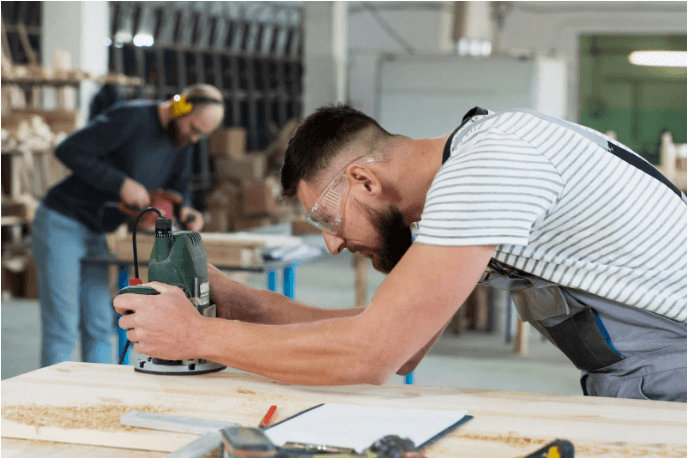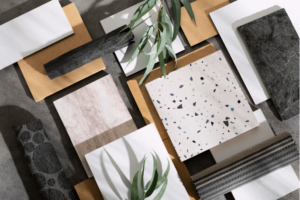Have you ever given the function of tiles in the rooms we live in? Are they just surfaces that we use in our bathrooms, kitchens, and outdoor spaces for utilitarian purposes? Or do they become expressive canvases that determine the aesthetics of our living spaces, surpassing their plain utility? It appears that changing customer preferences and the state of technology hold the key to the solution. With contemporary architecture increasingly demanding a blend of design and function, the process of making tiles is changing dramatically.
However modern design, tiles—once thought of as only a functional component of building—have become a statement of elegance and style. Tiles are no longer only useful surfaces for bathrooms, kitchens, and even outdoor areas; they are now considered design components that improve any space’s visual appeal.
Accomplishing Customer Demands: Obstacles Tile Manufacturers Face
Tile manufacturers encounter a number of difficulties in their conventional manufacturing process as they strive to meet the ever-increasing demands of consumers. Among these difficulties are the needs for long-lasting designs, eco-friendly materials, and aesthetic appeal. Nevertheless, these demands are frequently too much for the conventional procedures to handle. Modernization is therefore essential to overcoming these obstacles and successfully satisfying customer expectations.
Automation: Increasing Productivity in Manufacturing
Automation is one of the fundamental developments in upgrading the tile manufacturing process. From the processing of raw materials to packaging, robotic technologies have transformed many aspects of production. Automation decreases manufacturing time, increases productivity, and avoids errors by minimizing human interference. Tile manufacturers may now increase production speed without sacrificing quality.
Manufacturers can guarantee accurate and effective distribution of raw materials by putting automated material handling systems into place. In addition to cutting expenses and waste, this guarantees a constant level of quality in the materials utilized. Moreover, accurate and consistent tile cutting, shape, and finishing are made possible by automated equipment in the production line. The production process is made more efficient by the inclusion of automation technology.
Digital Transformation: Boosting Customization and Design
The design and customisation elements of tile production have undergone tremendous change as a result of digitalization. With the use of sophisticated digital design tools, tile makers can easily develop elaborate and distinctive tile designs. With the many customizing choices these tools provide, clients can select from a variety of patterns, colors, and sizes. Before commencing manufacturing, manufacturers can expeditiously create prototypes and furnish consumers with visual depictions of their preferred tiles.
The manufacturing process has also been transformed by computer-controlled production systems, which enable accurate and effective operations. Modern technology, such computer numerical control (CNC) equipment, allows producers to cut, shape, and edge tiles with extreme precision. This degree of accuracy guarantees that the finished goods constantly fulfill the required requirements.
Moreover, digitization has made customization and innovation more rapid. Using digital tools, manufacturers may swiftly generate new designs or adjust current ones in response to shifting consumer tastes and market trends. Their adaptability enables them to meet a greater variety of client needs and maintain an advantage over rivals.
A Step Towards a Greener Future with Sustainable Manufacturing
Sustainable production processes are becoming essential in the tile business due to growing environmental concern. Manufacturers are using energy-saving methods, recycling garbage, and adopting environmentally friendly products. Manufacturers of tiles can lessen their carbon footprint and meet consumer demand for greener products by implementing sustainable methods. This move toward sustainability meets the needs of environmentally concerned customers while also being good for the environment.
Recycled materials are used in production to minimize waste and cut down on the use of natural resources. Producers can produce tiles with less of an impact on the environment by using recycled glass, ceramics, or other materials. Energy-efficient tools and procedures, such solar panel installation or improved kiln firing methods, also help to lower energy usage. Water recycling technologies and the application of water management techniques both contribute to the preservation of this important resource.
Reaching Cost-Effectiveness and Efficiency
In addition to improving tile quality, contemporary technological solutions have also increased production process efficiency and cost-effectiveness. By eliminating the need for manual labor, automation streamlines production and lowers error risk. Manufacturers benefit from increased productivity and lower costs as a result. By reducing waste and facilitating quicker design iterations, digitalization maximizes production and leads to increased efficiency and lower costs.
Manufacturers can use real-time monitoring systems that track several parts of the production process to further increase efficiency. These devices save downtime and enable timely repair by offering insightful information about the machinery’s functioning. Manufacturers may maximize efficiency and guarantee continued production by swiftly recognizing and resolving difficulties.
Furthermore, supply chain operations can be optimized with the use of sophisticated inventory management systems, guaranteeing that the appropriate resources are available when needed. Manufacturers can improve cost-effectiveness and optimize processes by cutting inventory carrying costs and stockouts.
Market Trends: Shifting to Meet the Needs of Changing Customers
The tile business is adapting to shifting market trends in addition to technological advancements. Customers look for tiles these days that express their unique personalities and styles. Flexible production procedures are necessary in order to meet this need for personalization. Manufacturers are able to produce customized and distinctive tiles while staying up to date with changing market trends by embracing digitalization and cutting-edge production techniques.
Manufacturers can discover new consumer preferences and trends by using data analytics and market research. Manufacturers may modify their production procedures and launch new designs to satisfy changing market demands by having a thorough awareness of these expectations. With this flexibility, manufacturers can adapt to the constantly shifting needs of their customers and remain relevant.
Additionally, businesses can interact directly with their target audience through social media platforms and online marketplaces, which offer insightful data about customer preferences. Manufacturers can generate a powerful brand presence and a leadership position in their industry by actively participating in online forums and utilizing digital marketing tactics.
Future-Shaping Technological Advancements
Tile producers are utilizing cutting-edge technologies to update their manufacturing processes and successfully satisfy consumer needs in reaction to these market trends:
Advanced Materials: The increasing demand for environmentally friendly solutions is met by the development of new materials, such as sustainable ceramics, recycled glass, and porcelain. These materials are durable and aesthetically pleasing in addition to having a lower environmental impact.
Digital Printing: The ability to create complex patterns and shapes with unmatched accuracy because of digital printing technology which has completely changed the tile industry. With the unlimited customization options offered by this technology, customers may design distinctive locations that perfectly capture their personal aesthetic.
Augmented Reality (AR): In the tile sector, augmented reality (AR) technology has changed the game by offering customers immersive experiences. Customers may make confident decisions and lower the risk of buyer’s regret by using AR-enabled apps to see how various tiles would look in their space.
Automation and Robotics: Robotics and automation have expedited the manufacturing process, increasing accuracy and efficiency while lowering labor expenses. Tasks like cutting, shape, and packaging are handled by automated systems, which guarantee consistency in quality and reduce errors.
Nano-Coating Technology: Tiles are made more resilient and long-lasting by an additional layer of protection against stains, scratches, and water damage thanks to nano-coating technology. With the help of this technology, tiles perform better and require less care, which increases their consumer appeal.
Conclusion
Technological developments that are aligned with current market trends are causing a fundamental revolution in the tile sector. These developments, which range from digital printing and augmented reality to sustainable materials, are changing the production and use of tiles.
Tile producers must adopt these technical advancements in order to remain competitive in the dynamic market, since consumers continue to place a premium on sustainability, personalization, and quality. Not only is the tile industry satisfying consumer needs, but it is also raising the bar for innovation and quality by skillfully utilizing technology.
How Technology and People Are Changing the Tile Manufacturing Industry 💡
Our most recent piece reveals the driving force behind the tile industry’s change in a time when technology and tradition collide. Learn about the experiences of talented individuals and creative thinkers who are redefining the industry by fusing traditional methods with cutting-edge approaches. Come along as we investigate the human touch in a technologically advanced tile manufacturing era. Let’s honor the designers and engineers paving the path for a future that is more environmentally friendly and mindful of design. 🌼



